When and how to top cannabis to increase yield

What is topping cannabis?
Topping cannabis is a high stress training (HST) technique where the top of the main central stem is removed. This takes away the dominance of the central stem (known as 'apical dominance') and encourages lateral growth. Once the apical dominance is removed a cannabis plant puts more emphasis into growing its smaller side branches. This results in a wider structure, and when partnered with LST training allows you to alter the plants shape into a flat canopy.
Without removing the top of the main stem, cannabis plants will exhibit apical dominance and the central stem will be given preference to the plants energy causing it to grow taller then the rest of the plant. When grown without training this is what creates the typical Christmas tree style shape of most cannabis plants.
Grown outdoors where the sun rises in the east and sets in the west, this Christmas tree style shape is excellent at allowing for good light coverage. However, grown indoors with a fixed light position, a cannabis plants shape needs to be altered to optimize light distribution. This is where topping comes in.
- What is topping cannabis?
- When should you top cannabis plants?
- When should you not top cannabis plants?
- Does topping increase yield?
- Week by week examples of topping cannabis
- How stressful is topping on cannabis plants?
- Can you top a cannabis plant during the flowering stage?
- Step-by-step how to top a cannabis plant
- Is topping the same as fimming?
- What are other less stressful alternatives to topping?
When should you top cannabis plants?
Cannabis plants are delicate when they are young and too much stress could kill them. You should not top a plant until it is in the vegetative stage and able to comfortably handle this process. To judge when to top a cannabis plant you should count the number of nodes and make sure your plant has at least 4, to be on the safe side you should always leave topping until after the 6th node. By this point your plant should be firmly in the vegetative stage and be able to handle a little bit of stress.
When should you not top cannabis plants?
Cannabis topping isn't for everyone, it is a high stress training method and some growers do prefer to just keep things simple and use less stressful LST techniques. The suitability of topping also depends on the type of cannabis that you are cultivating and where you growing. So what kind of cultivators is topping best suited to?
- When growing some autoflowers - You can top autoflower strains, however as we have explained, topping is a HST training technique and therefore plants need some recovery time. Autoflowers have much shorter vegetative and flowering stages which means they have less time to recover. Topping can work on sativa autoflower strains that have longer growing times. But topping should not be done on any autoflowering strain with a short growing time. Alternatively if you are looking to increase the yield of an autoflower, you can safely use low stress techniques such as SOG or ScrOG on any strain.
- If your plants are stressed - Topping is a high stress technique, if your plants are exhibiting any signs of stress or don't look healthy do not top them as this will only add to the problem.
- When you are close to the flowering stage - For the best results topping cannabis should ideally be done in the early vegetative stage this will allow your plants to both recover and grow in time to flower. For outdoor growers this is incredibly important because once the light begins to change you wont have long before your plant begins to flower.
Does topping increase yield?
When it is done correctly and on strains that are bred to produce lots of bud topping can increase yield drastically. Topping a marijuana plant allows you to manipulate its shape and optimize light distribution. This allows your plant to absorb more light, resulting in improved photosynthesis and better bud development. When partnered with LST techniques, topping encourages lateral growth resulting in multiple larger bud sites instead of one main cola.
What are the benefits of topping?
- Increase yield.
- Control over the shape of your plants.
- Reduces the height of plants.
- Increase the number of colas.
- Optimizes light distribution and grow space.
What are the negatives of topping?
- Topping places the plant under stress.
- Can be risky to do on autoflowers or fast flowering strains.
- Best suited to more experienced growers.
Week by week examples of topping cannabis
Top give you an idea of how topping affects the growth of a cannabis plant here are some week by week images of what you can expect from your grow. Normally for inexperienced growers we would not advise topping autoflowering cannabis plants because of their short veg stages which may not allow a full recovery before flowering begins. However, in this instance, we have managed to successfully top Acapulco Gold Auto, we chose this strain because being a sativa dominant strain it has a longer growth cycle and thus has a little longer to recover from any stress.
Strain: Acapulco Gold Auto
Here you can see the plant the day before topping, and then after removing the top growth of the plant, what you are left with is a tiny portion of the main stem, along with the two side branches. These side branches will now grow to become larger bud sites thanks to topping.
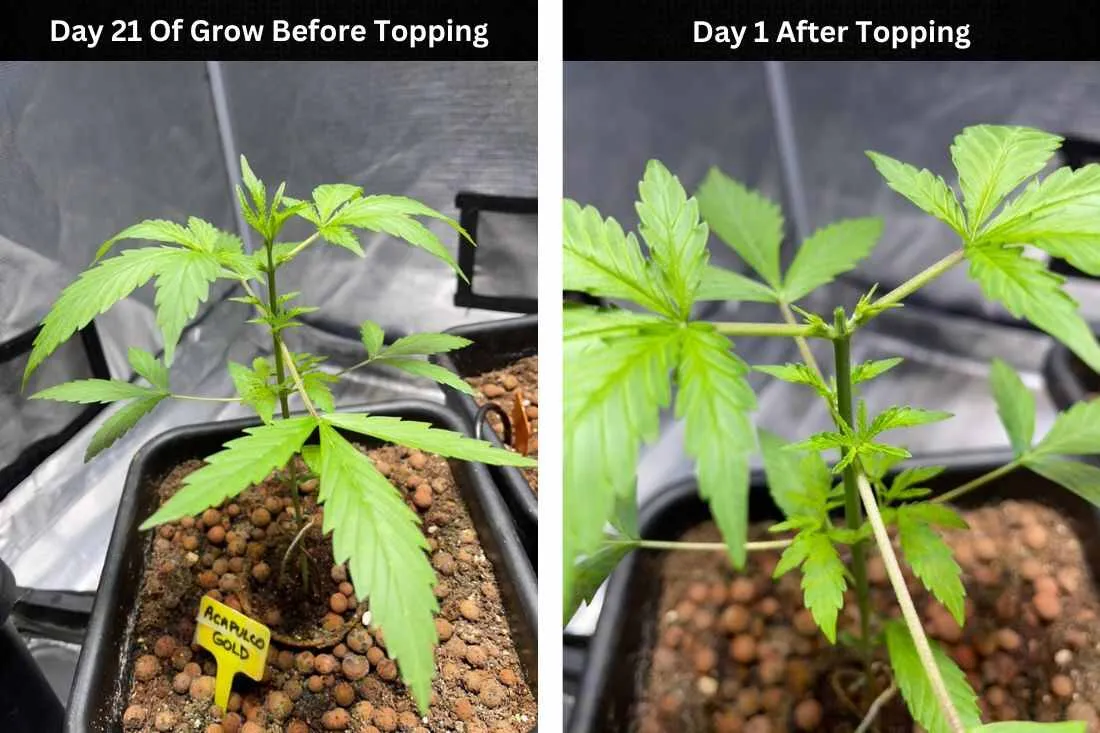
As you can see just 1 week after topping our plant, the recovery has been quicker than we could have hoped and she is not showing any signs of stress.
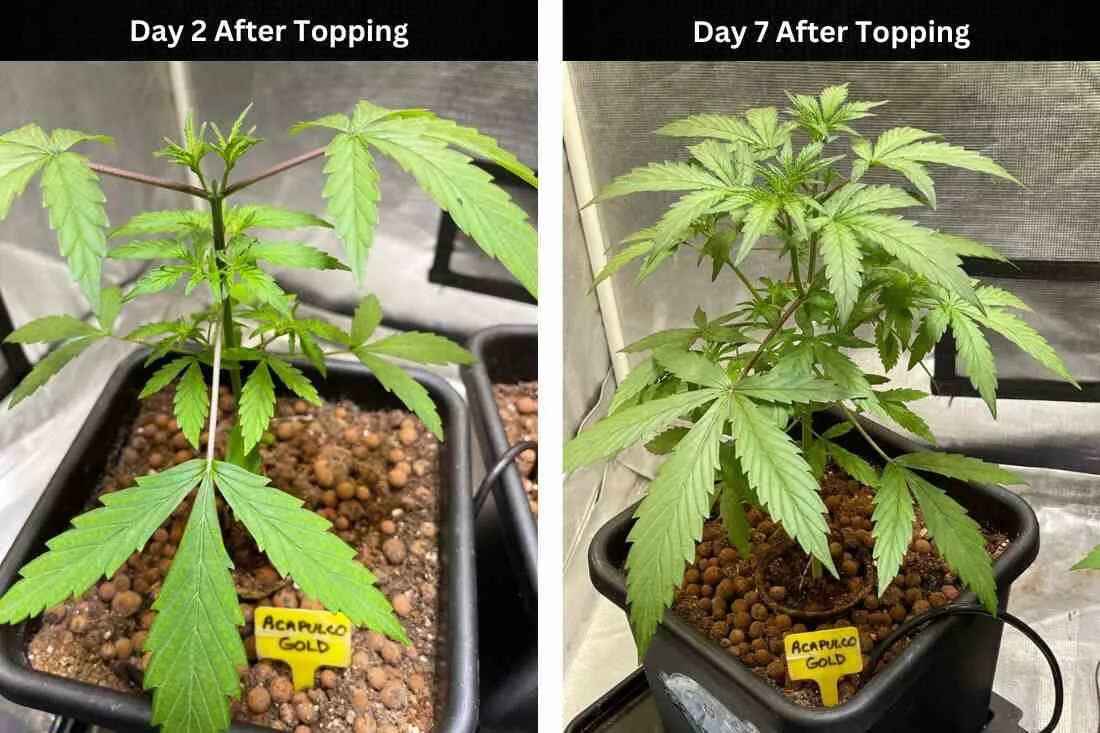
Day 12 after being topped you can see that our autoflower is really putting on some size and is now close to being fully grown as the early signs of flowers are beginning to show. Jump forward 3 weeks, to week 5 post top and we can see that the plant is now fully in bloom with a few large developed bud sites.
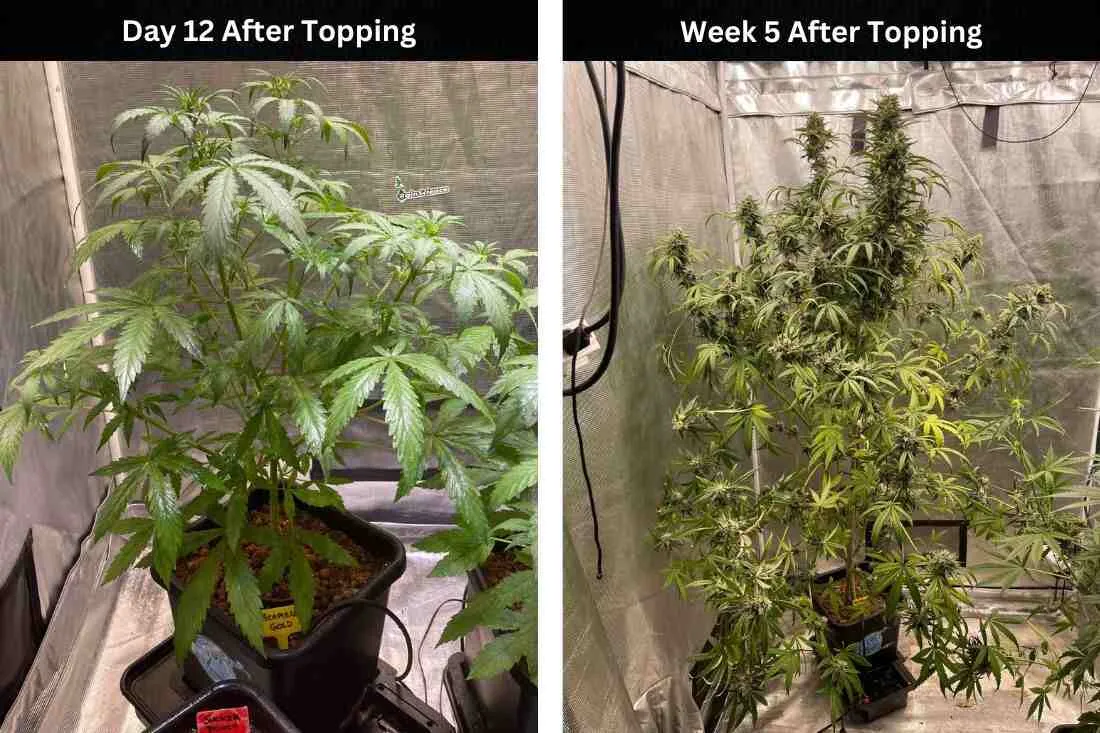
Week 6 after topping and it looks like we are pretty much done. As you can see the plant has really come a long way in just 6 short weeks and now has plenty of big juicy nugs ready for us to harvest.
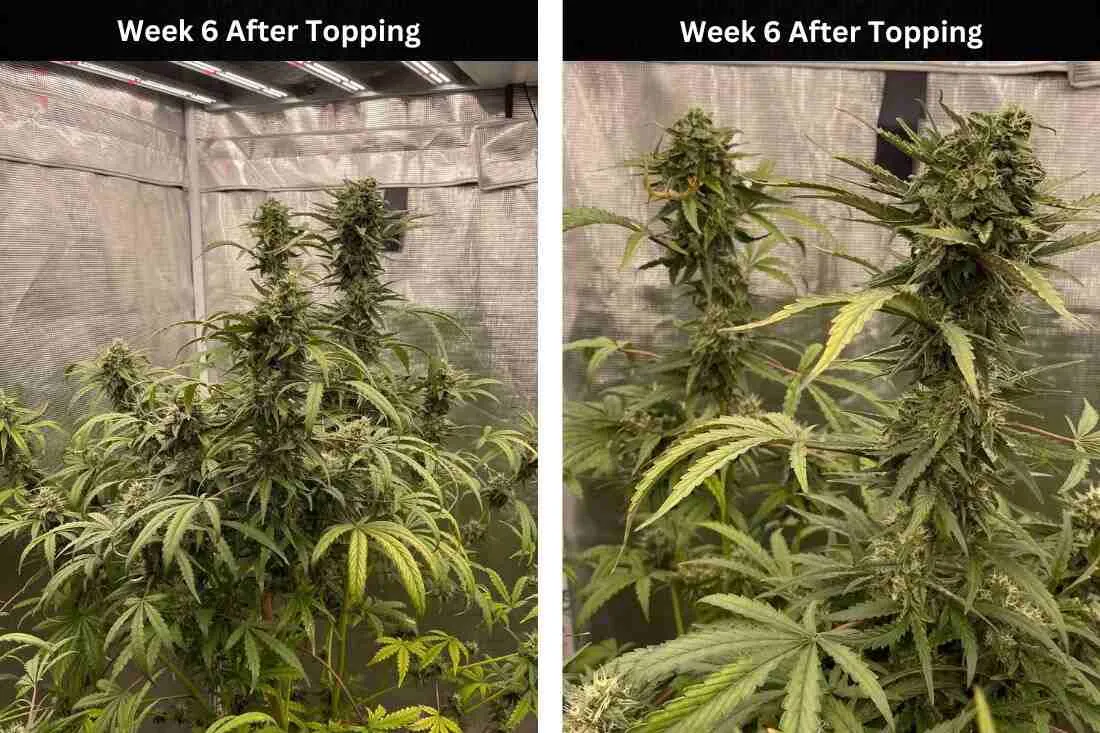
How stressful is topping on cannabis plants?
Topping involves cutting off part of the main central stem, this will cause some stress to the plant. However when done correctly and with a sharp pair of scissors a plant should make a full recovery within a couple of weeks. You should allow at least a few weeks recovery to allow the plant to fully establish its new stalks before any further pruning.
Can you top a cannabis plant during the flowering stage?
No. As we have explained topping is a high stress training technique and you should not top a cannabis plant during the flowering stage. Once a plant has reached the flowering stage its focus should be on producing bud. By inflicting stress upon a plant this late in its life cycle you could halt its bud development until it fully recovers.
Step-by-step how to top a cannabis plant
The first time you top a plant, it’s a good idea to cut above the sixth node. This will ensure there are enough branches on the bottom for the plant to become bush and that the plant is developed enough to handle a little stress.
Once that first topping is done, you can then use your judgement as to how many nodes to cut above. Many growers choose to cut two or three nodes up, but it will depend on your own preferences and how bushy you’d like the plant to be.
After you’ve chosen where to cut, the procedure is very simple.
- Disinfect a pair of pruning scissors or a razor blade. This will ensure bacteria does not cause an infection in the plant. Rubbing alcohol is enough to sterilize your tool.
- Sharpen the tool you’re using if needed. You’ll cause the least amount of stress to the marijuana plant by making one clean cut.
- Decide where you’re going to make your cut. When topping, you’ll choose from the node instructions above. Two new stalks will form where you cut, producing more colas and more buds.
Topping is considered to be a high-stress training technique. Once done, it’s a good idea to allow the plant some recovery time. This can take several weeks as the plant heals and directs its energy to more stalks. Only after the plant has stabilized should you top again.
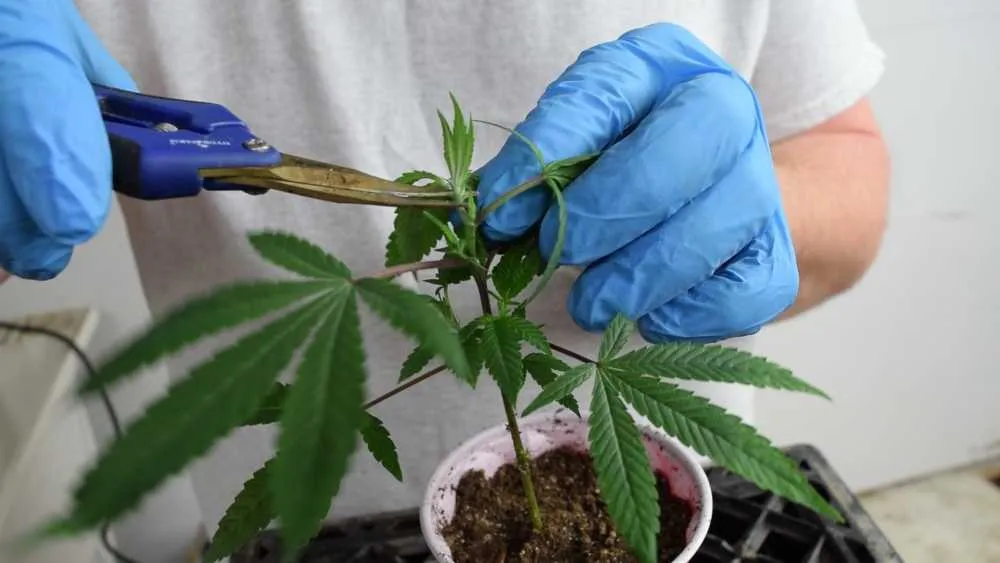
Is topping the same as fimming?
Fimming is another HST training technique with similar objectives to topping but with a slightly different approach. 'Fim' stands for 'Fuck I Missed' and refers to the way a plant looks immediately after fimming it. When you fim a cannabis plant instead of fully cutting off the top of the main stem you only remove 75% of it. What you are left with looks like a poorly topped cannabis plant. The remaining 25% of the stem resembles a small tuft grass and from this four new colas will grow instead of the one main stem.
What are other less stressful alternatives to topping?
If you want to try a less stressful alternative to topping cannabis that can help to increase yields, some of the most successful methods are LST, ScrOG, and SOG.
Low Stress Training (LST): LST involves using gently bending the branches of the plant to grow horizontally, rather than vertically. This helps to create a more even canopy and promotes the growth of multiple bud sites. By bending and securing the branches, the plant is encouraged to grow wider rather than taller, which can help to increase yields and make the most of available grow space.
Screen of Green (ScrOG): ScrOG involves using a screen or net to create a horizontal canopy, similar to LST. However, instead of simply bending the branches, the plants are trained to grow through the screen or netting, which helps to create an even canopy and maximize the use of grow space. This technique is especially useful for indoor growers with limited space and can help to increase yields by promoting the growth of multiple colas.
Sea of Green (SOG): SOG is not so much a training technique, it is more of a style of growing. SOG involves growing lots of small plants tightly packed together to make best use of the grow space. This technique requires a lot of planning and careful monitoring to ensure that each plant is getting enough light and nutrients, but it can be a highly efficient way to grow cannabis in a limited space. By keeping the plants small and focusing on early harvests, you can produce multiple crops each year and achieve high yields without the need for time consuming and sometimes stressful training methods.
-
20+ Years Experience
Over 500K seeds sold worldwide
100K+ Happy Customers -
Germination Guaranteed
Complete satisfaction or we will replace your order -
Dutch and USA Genetics
Master breeders inspiring strains from across the world -
1-5 Day Delivery - Guaranteed
Free Express Shipping to the US, Canada and UK








